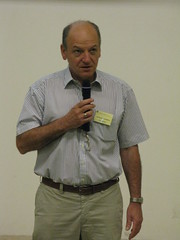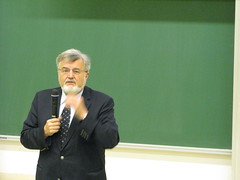Thursday, October 28, 2010
HPM Newsletter 75
It can also be read online at HPM Newsletter's website, which is currently in a test phase.
Wednesday, August 4, 2010
ESU6 Day 5
I did, however, take part in Snezana Lawrence’s workshop “Digitising the past mathematics by the future mathematicians”. It concerned how working on earlier textbooks may be interesting for today’s schoolkids. For instance, they may be interested to see that earlier textbooks (based on Euclid), actually gave definitions in a way that are almost gone now. Nowadays, textbooks give explanations with pictures and words, perhaps making it less clear what is the core definition and what is examples or illustrations. The workshop did not, however, give a very clear idea of what Snezana thinks that the role of “digitising” should be in this. While I do see that students could learn from scanning and transcribing short portions of text and then making it publicly available, I’m not convinced that it is worth the time. (And the other members of my group in this workshop was rather convinced it was not worth the time.) However, the work we did in the workshop was a good illustration of some of the points Michael Glaubitz made in his plenary lecture.

That marks the end of the conference. It was hard work. I leave the conference inspired and with a wish to continue working on history of mathematics. However, I also think that I was a bit too busy at this conference. In the end, I got to choose five of the workshops, but none of the oral presentations (I was always either speaking or being a chair). Having presentations on three of the days (one oral presentation, one workshop and one panel) is a bit too much also, both in the weeks ahead of the conference and in the conference itself.
I look forward to the HPM Meeting in Korea in 2012 and the ESU7 in Spain (maybe) in 2014.
Tuesday, August 3, 2010
Euclid in color
I hope I'll get my library to lend me a copy - it will be interesting to see how Euclid changes when a pedagogical use of colors are included. I fear that there may be some unintended consequences... (I haven't yet checked if any historian of mathematics has written anything on this particular book - I would surprised if noone has.)
Have a look at the book at Taschen's homepage (linked to above) - it's really unusual.
Sunday, August 1, 2010
ESU6 Day 4
While a genetic approach is usually considered a means of introducing a topic (the pupils will meet the topic in the same order as it was developed in history), a hermeneutic approach (as suggested by Jahnke) concerns reading original sources when already having pre-knowledge about the topic concerned.
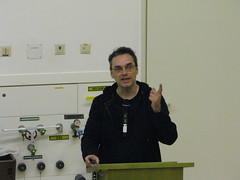

Glaubitz set up three teaching sequences of equal length which were then taught in different groups of students by different teachers. The genetic approach failed miserably, while the hermeneutic approach did significantly better than the conventional approach. Of course, such an experiment can never be a proof of the non-feasibility of an idea, so the results for the genetic approach are not the most interesting ones. However, it is a bit impressive that teachers used to the conventional approach can be guided into teaching successfully with original sources (using the hermeneutic approach) in such a short time. (Although we may of course, as always, have the effect of trying something new.)
To me, this is very promising results. The genetic approach seems too ambitious to me – in a way, you need to take into account all the history of mathematics at the same time, which puts enormous demands on the teachers’ knowledge. The hermeneutic approach delves into one particular point of time and one particular context. While that is certainly also demanding, it seems more like something many teachers could be willing to try – given the right materials.
The second plenary lecture was Raffaele Pisano’s “Which is the cultural and interdisciplinary role played by physical and mathematical sciences? Epistemological Reflections”. This talk concerned the connections between physics and mathematics. To be perfectly honest, I have never had a physics course in my life, and therefore found most of the lecture too advanced for me. (Which doesn’t say much, of course.)

Then there was another panel. The title was “The role of the history and epistemology of mathematics in pre-service teachers training”. The panelists were Evelyne Barbin, Fulvia Furinghetti, Snezana Lawrence and myself. I did not take notes during this panel (except notes on what I was going to say), so I’m not the right person to try to summarize it. However, for me personally, the main outcome of the panel itself and the preparations for it was a realization that it is time that I do something a bit more substantial when it comes to making history of mathematics available to teachers. It’s been ten years since my first HPM conference (in which I complained about the quality of Norwegian textbooks), six years since my second HPM conference (and first ESU) (in which I complained about the quality and quantity of history of mathematics in the TIMSS Video Study materials), three years since my second ESU (in which I did not complain actually – but showed examples of history of mathematics I’ve used in teacher training) and two years since my third HPM (in which I discussed teachers’ conceptions of history of mathematics). Isn’t it time for me to come to a HPM or ESU with a textbook or webpage and discuss why I have created this wonderful book/webpage in this way? Maybe in 2014?
I could mention that my part of the panel discussion was taking Deborah Ball’s model of teacher competence in mathematics as a starting point. My own preparations on this – as well as a question in the discussion – made me realize that I have to revisit Ball’s articles to see what her (and her colleagues’) conception of “mathematics” is.
After lunch, I attended Kristín Bjarnadóttir’s workshop “Arithmetic textbooks in 18th century Icelandic manuscripts”. I think I would have found such a workshop painstakingly boring ten years ago, but I’ve grown to appreciate the study of textbooks as a valuable part of research on history of mathematics. Moreover, the kind of “detective work” that Kristín has been doing here and which she invited us to take part in in this workshop, is rather fascinating. Her object of study is an Icelandic manuscript, and she wants to find out as much as possible about which textbooks influenced it. The “detective work” consists partly in finding out which textbooks were known in Iceland at that time, and of comparing “her” text with these. From time to time, there are clear “hits”, when numerical examples are exactly the same in different textbooks – they must clearly have a common source.
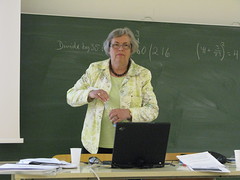
In Norway, there has been published a book on the first Norwegian mathematics (arithmetic) textbook: Tyge Hanssøn’s “Arithmetica Danica” from 1645. While the author (Geir Botten) has done lots of work on this book, he has not done research on the influences of the textbook (as far as I know). It would surely be interesting to see the results of such a study at one point.
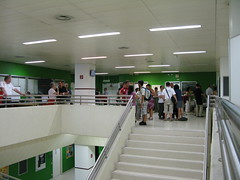 coffee break area
coffee break areaThe evening program was again oral presentations. Again, I was chairing (or cheering). There were three talks: Oscar Abdounur talked about the University of Sao Paulo, and how the invitation of European scholars to the university influenced it. Andreas Christiansen (whose name was terribly mispronounced by the chair – it’s a surprise that Christiansen (not Christensen) managed to speak after such an insult) spoke about Bernt Michael Holmboe’s textbooks and in particular how the concept of irrational number was presented in different editions, compared to how mathematicians elsewhere defined irrational numbers. Thirdly, Nuno Dias talked about the Portugese mathematics education, in particular after the Jesuits (who controlled Portugese education) were expelled in 1759.
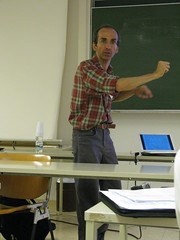

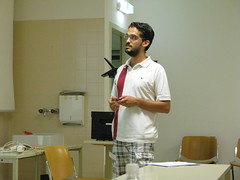
Thursday, July 29, 2010
ESU6 Day 3
The plenary lecture of day 3 (Wednesday) was Marc Moyon’s “Practical Geometries in Islamic Countries: the Example of the Division of Plane Figures”. Again, this is so far from my tiny area(s?) of competence that I will write little about it – in an attempt to make no errors (except errors of omission, of course). However, one main point is that mathematicians in these countries knew how to divide plane figures in different ways (for instance to divide three equal squares so that they could be put together to form one larger square). Craftsmen also knew how to do this – in ways that were not mathematically correct, but that were visually correct. Part of this lecture was about the relationship between the two.

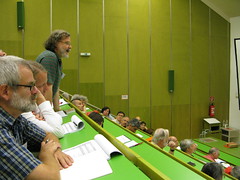
Michael N. Fried asking Marc Moyon a question. Andreas and Uffe are listening.
Sunwook Hwaan presented the plans for the HPM 2012 conference which will take place in Daewoon, an hour or two from Seoul (where the ICME conference will be). The information given in such a presentation is always less important than just assuring the audience that the planning process is going smoothly, and we certainly got a good impression from this presentation.
Then there was a panel discussion on “The history of mathematics in school textbooks”. The panelists were Anne Boyé, Adriano Dematté, Ewa Lakoma and Costantinos (Costas) Tzanakis. Part of the discussion confirmed that the situations in different countries are quite similar in many respects. I started my HPM “career” in 2000 by describing how history of mathematics is treated in Norwegian textbooks (after the 1997 reform of the curriculum). There were lots of errors, biographical details with no real significance and meaningless tasks for the children to do.
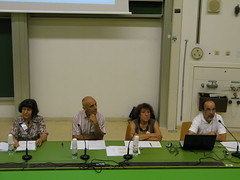
In this discussion, Dematté noted that there is too much “reading about” and too little “doing mathematics” when history of mathematics is in the textbooks. (According to publishers and teachers, history of mathematics is for reading.) Ewa Lakoma noted that history of mathematics tends to become a “set of curious details” instead of a source of stimulating contexts. Costas (quoting someone, I’m sorry I missed whom) asked if the history of mathematics in the textbooks makes the students spectators. Boyé gave the example of a task from a textbook: “Archimedes is a famous ancient greek mathematician. He was born in Syracuse in 287 B. C. and died in 212 B. C. How many years did he live?” This sort of meaningless exercise was also in the 1997 material of Norwegian textbooks.
This was a very well prepared panel, in that the main contributions of the panel were published in advance and people were asked to prepare comments. I had prepared a comment on a section on different ways of including history of mathematics in textbooks. I find the question a bit strange, as if you have the history of mathematics in your left hand and your textbook in your right hand and you want to include some of the history in the textbook that already exists. Contrary to this, one may say that as history of mathematics is an integral part of mathematics, history of mathematics should be a natural, explicit and integral part of the textbooks. I gave the example of textbooks on literature: I do not think that textbook writers on literature first write about the literature, for instance “Romeo and Juliet”, and then sit down and wonder “Maybe we should mention Shakespeare? How could we include the history of literature in this literature textbook?” But, on the other hand, a textbook has to have an audience; otherwise it will not be very useful. To write a textbook that is brilliant but that no one will ever read is a futile exercise.
That, surprisingly, was the end of the third day. After getting used to working till at least 8 at night, it was welcome to finish before lunch – if only to get time for some meetings that would be difficult to arrange otherwise. In the afternoon, there were sightseeings. I very much doubt that you will want the details of that. And then there was a reception in the “Rathauskeller” (town hall cellar), which was a splendid place.
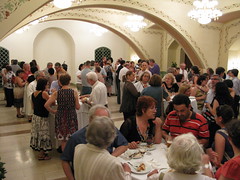
Tuesday, July 27, 2010
ESU6 Day 2
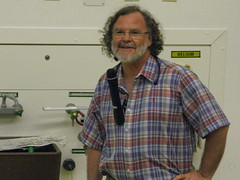
He first reminded us of the danger of a “Whig interpretation of history”, meaning, for instance “to praise revolutions provided they have been successful” (Butterfield). In history of mathematics, this often takes the form of showing how we got where we are today. The problem with this is, of course, that history is not about describing how we got where we are today, but to understand people of the past based on their own context. Fried gave the example of the idea of similarity in geometry, and claimed that while our concept of similarity is a “unified” concept based on transformations of the space, in Greek mathematics, there were separate definitions for different areas of use. For instance, if you wanted to define what it would mean for conic sections to be similar (as Apollonius did), you had to know something about conic sections and define similarity based on the pertinent attributes of the conic sections.
Thus, to teach the history of similarity, we will either have to take the students on a journey a bit longer than the way directly to transformations, or we will have to give a “Whig version” of the history.
So where should we put history of mathematics? That is a strange question, it’s as if history of mathematics is something outside mathematics. To the contrary, history of mathematics is an integral part of mathematics, and the more useful question would be “how do we design a curriculum consistent with a historical view”? (I’ll come back to this discussion when I write about Wednesday’s panel on textbooks.)
Then, Kostas Nikolantonakis and myself had a workshop on “Historical methods for multiplication”. Kostas discussed the method used by Eutocius of Ascalon in his commentary to “The measurement of the circle”. The participants were given the task of translating the numbers from the Greek alphabetic system to the modern numerals. Then we discussed the algorithm compared to the modern one and discussed the situation in schools today. One advantage of Eutocius’ method is that you write down all products in full, instead of having to move one to the left, writing some numbers below and some above and so on, as in the modern algorithm of multiplication.
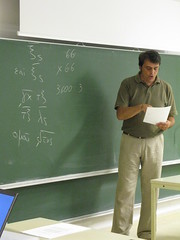
Greek algorithm to the left, a partial translation to the right
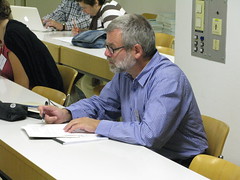
Participant concentrating on the translation
In the second part of the workshop, we discussed the method of “casting out nines”, based on a version of this found in Tyge Hanssøn’s “Arithmetica Danica” (discussed extensively in Geir Botten’s book which was published last year). An interesting insight I got from this is that there are actually two different ways of viewing this algorithms. I have always seen this as concerning “repeated digit sums” (“tverrsum” in Norwegian), where you take the sum of all the digits and then repeat until you have only one digit left. In other countries, as the name “casting out nines” suggest, they do not take the sum of all the digits, but rather remove nine whenever they get above nine. An example: 76292. I would find the repeated digit sum like this: 7+6+2+9+2=26. 2+6=8. Others would do it like this: 7+6=13, that leaves 4 after casting out the nine. 4+2=6. 6+9 = 15, which leaves 6. 6+2 = 8. The methods are obviously equivalent in their result, but feels a bit different.
Anyway, now I’m discussing what I learned from our workshop, not the contents of it. We went on to talk about the history of this method, and in the end spent some time discussing the role of different algorithms in teacher education. Here, I put Deborah Ball (etc)’s model on the wall and discussed that a little.
Then over to the day’s three-hour workshop. Man Keung Siu’s workshop was on “Inscribed square in a right triangle”. Yes, that’s right – we spent three hours inscribing squares in triangles (although not all of them right ones, actually). And I was exhausted afterwards, because the workshop involved so much thinking.
But first, before going on: given a right triangle ABC (where B is the right angle), how would you find a square DEFG such that D=B, E is on BC, F is on AC and G is on AB? (I must admit that at first I solved it using coordinates – which is quite a modern way, of course.)
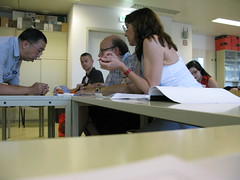
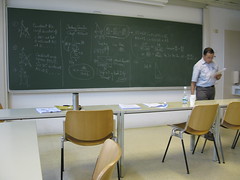
The workshop was based on Chinese solutions of this problem, both before and after the influence of Euclid had come to China. The influence can be seen, as the proofs were changed significantly. However, I will refrain from trying to explain more about this here, as I would surely get lots of the facts wrong – not to mention the names of the Chinese mathematicians and texts.
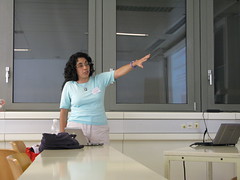

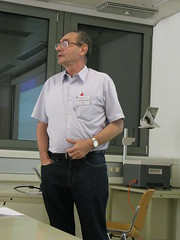
The last part of the day was again devoted to oral presentations. I was the chair of one of the sessions, a role which I choose to interpret as presenting the speaker and then keeping track of the time. With only 30 minutes, including questions and comments, for each speaker, I think they prefer the chair to be brief… The three speakers in this session was Gabriela Buendia Abalos, who talked about the use of the periodic property through history, and how it has evolved out of a need for prediction, Oscar Abdounur (stepping in for Adriane Cesar de Mattos) on a paper of George Boole and finally Gérard Grimberg, on the development of the geometric interpretation of complex numbers. Of course, I was interested to see which role Caspar Wessel’s work on complex numbers would get in this last talk, both because it was long overlooked and because it is – as Grimberg noted – not as much a geometric interpretation of complex numbers as a analytical representation of geometric objects. (Wessel’s background was in surveying, of course.)
That marked the end of the second day of the conference, one might imagine. No! There was a meeting at eight o’clock. The Advisory Board of the HPM (in which I am a member in my role as Newspaper editor) had a meeting/dinner. As usual in these meetings, it is a bit difficult for the people at one end of the table to hear what the people at the other end of the table say, so many of us were a bit curious as to what had been decided. I’m joking, of course – moreover, the Advisory Board does not decide things. The chair of the HPM makes decisions, after seeking advice in the Advisory Board.
An example of a topic discussed was whether the next HPM meeting (in Korea in 2012) should have its proceedings published before or after the conference. I think it was decided that they should be available before the conference. At my end of the table, we discussed whether it could then be called “proceedings”, and I proposed “preceedings”. Anyway, there are many advantages to having “preceedings”: for quality control, making it easier to find talks and workshops you’re interested in, making it possible to read contributions you can’t attend and then talk to the person at the conference instead of having to do that one year later. For many, the “preceedings” will not be the final publishing of the paper, as they will revisit the paper after the conference and then send an improved version to some journal or other.
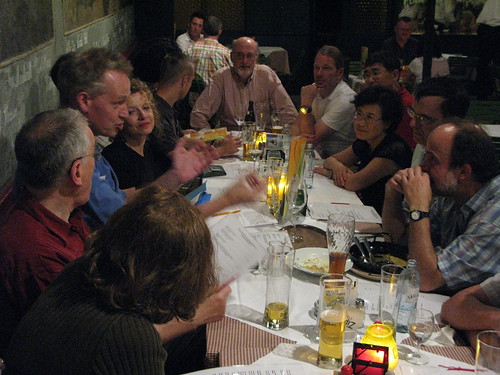
The food was delicious, by the way.
Wednesday, July 21, 2010
ESU6 Day 1
The conference was opened by Mannfred Kronfeller, the main organisor of the conference, and by the Vice Rector of the Technical University of Vienna, Hans Kaiser.
There were also short introductions by Evelyne Barbin, the chair of the HPM group, who outlined the history of the ESUs, and by Costas Tzanakis, who mentioned that representatives of 28 countries are present at the conference. That's not bad.
The first plenary speaker was Uffe Jankvist from Denmark. He talked about a teaching experiment that he has conducted (and which formed part of his PhD), where the history of mathematics played a major part. The topic was error-correcting codes and cryptography. But while this was the background of his talk, his real concern was to get more specific about what role history of mathematics can have in teaching. In particular, he studied whether he could see signs that the students would have meta-issue reflections on mathematics that were anchored in the mathematical in-issues that they were working on.
I find Uffe's approach very interesting. Instead of just claiming that "history of mathematics can make students reflect on the epistemology of mathematics", for instance, he sets out to study particular interpretations of this claim. It makes for a more nuanced and informed view of the part history of mathematics can play.

Uffe argues powerfully for the use of empirical studies (in this sense) in research on history of mathematics. I agree that this is one important path to follow. However, I believe that we still need the other paths as well. While studies such as this are convincing, they do too little to provide examples and materials for teachers to trz. For many teachers, successful attempts at including history of mathematics in their own classrooms are more powerful than researchers' results.
Then there was time for workshops. Workshops form a major part of the ESUs, as the ESU is supposed to give more "hands-on-experiences" than ordinary conferences. I attended Masami Isoda's workshop on how he has used the dbook software to create digital editions of textbooks with appended interactive materials. The example given was of historical instruments (from van Schooten's book). We were also given the chance of recreating the historical instruments by means of paper (see the wonderful instrument created by the group consisting of Jan van Maanen and me - I must admit that Jan did most of the work...)

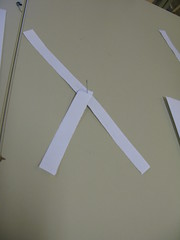
I think this is an interesting way of connecting the textbook with more interactive media.
Then I attended a three-hour workshop with Uffe Jankvist. There have been discussions during the conference of whether the three-hour format is too long. In my opinion, Uffe's workshop provides an existence proof that three hours may at times be about the right amount of time. Uffe wanted the participants to analyze some bits of transcripts with the same analytical tools that he had used in his PhD. In the beginning, the participants were quite hesistant, as both the mathematical and historical topic under consideration was unfamiliar and the analytical tools were new to us. However, by the end of the workshop, it seemed to me that everybody was participating in trying to find the "potential anchoring points" that Uffe was interested in.
As mentioned above, I think that there is great potential in getting more detailed concepts of how history of mathematics may be included in teaching, making it possible for teachers to be more conscious about exactly which effects they are trying to produce in a particular circumstance.
Oral presentations are not such a high priority at the ESUs, so on Monday they were taking place from 1830 to 2000 at night. Gerlinde Faustmann talked about "Classroom experiences with history of mathematics", following the path mentioned above of providing examples and ideas for teaching mathematics using history. Then I had my presentation on the Norwegian literature on history of mathematics, where I outlined several points of potential improvements. (I keep thinking I should write a book on the subject - but where is the time for it...) And finally, Po-Hung Liu discussed "the evolution of college students' epistemological views of mathematics in a history-based class". This was a combination of teaching ideas with a somewhat detailed look at what students did get out of it.

Of course, giving such a short summary of the first 11 hours of the conference does not allow for too many details. The proceedings of the conference will be available perhaps a year from now, so more details will be obtainable there...
I will continue with a discussion of day 2 in a later post.
Monday, July 12, 2010
European Summer University (ESU 6)
The programme (available at the ESU6 website) has lots of interesting stuff, often with six events in parallell, so already it is time to lament all the good talks I will miss. However, such is life at big conferences. Here, I'll instead write about what I won't miss:
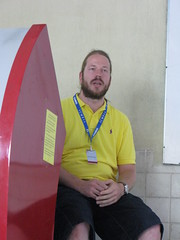
Uffe
The conference opens on Monday 19th of July. Uffe Jankvist will give the first plenary lecture, which seems to be based on his newly finished PhD (on historical modules in code theory). I will of course be attending this lecture. Afterwards, I will probably choose Masami Isoda's workshop on "Using historial instruments and interactive e-Textbook for experiencing the interpretation of historical textbooks" (although there are particularly many interesting workshops simultaneously). After lunsh, it seems reasonable to attend Uffe's three-hour workshop on "Students' meta-issue discussions of history of mathematics". As if that wasn't enough, there is an evening session of oral presentations, where Gerlinde Faustmann will talk about "Classroom experiences with history of mathematics", yours truly will talk about "History of mathematics in Norwegian - a literature review" (although the title in the program is "Making history of mathematics available to teachers - one page at a time"). And then Po-Hung Liu will speak about "Evolution of College Students' Eopistemological Views of Mathematics (...)". Then, finally, it's eight o'clock, and it's time to find a wiener schnitzel or something...

Kostas and me in Greece last year
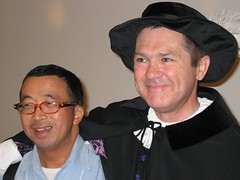
Man Keung Siu (with Peter Ransom)
Tuesday will begin with a plenary lecture by Michael N. Fried ("History of Mathematics in Mathematics Education: Problems and Prospects"). Right thereafter, Costas Nikolantonakis and yours truly will have a two-hour workshop on "Historical methods of multiplication". After lunch I will be relieved to be finished with the main part of my obligations at this conference. I will go to Man Keung Siu's three-hour workshop on "Inscribed square in a right triangle". Then, I'll have no choice, as I am the assigned chair of one of the sessions: I will chair three talks on "The use of periodic property through history (...)" (Gabriela Buendía Abalos), a study of a paper by George Boole (Adriana Cesar de Mattos) and "The geometric representation of complex numbers and education" (Gerard E. Grimberg). And as if that was not enough food for thought for one day, I will take part in the meeting of the HPM Advisory Board from 8 o'clock - hopefully accompanied with dinner.
Wednesday will feel like a day off after these 11 hour days. There will be a plenary lecture by Marc Moyon on "Practical Geometries in Islamic Countries" and a panel discussion on "The history of mathematics in school textbooks". The rest of the day is put aside for lunsh and excursions - as well as a cocktail reception in the evening.
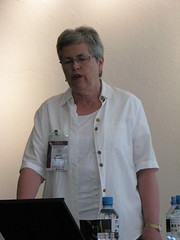
Kristín Bjarnadóttir
Then there's Thursday. Michael Glaubitz will give a plenary lecture on "The Use of Original Sources in the classroom - Empirical Research Findings". Michael was one of the editor of the proceedings from the Oberwolfach meeting on original sources some years ago, and it will be interesting to hear him again. The next plenary lecture, by Raffaele Pisano, will contain epistemological reflections on "the cultural and interdisciplinary role played by physical and mathematical sciences", according to the program. My mind will probably be with the next thing on the agenda: the panel discussion on "The role of the history and epistemology of mathematics in pre-service teachers training". I will be one of the participants of the panel, and this will also be my debut in the plenary of such a conference. After that - and lunch - I will attend Kristín Bjarnadóttir's three-hour workshop on "Arithmetic textbooks in 18th century Icelandic manuscripts". I last heard her at the HPM in Mexico City two years ago, and she is always interesting. And finally, I believe I'll listen to José Manuel Matos and Mária Almeida on "Shaping a modern mathematics pedagogical content knowledge: the case of Telescola in Portugal in the middle 1960s" as well as Catarina Mota's "The concept of tangent line: historical and didactical points in its teaching in Portugal".
Which leaves Friday. I may want to skip the plenary lecture on ICMI's first century, as I've heard Fulvia lecture on the topic before. Then I will probably choose Michael Glaubitz's workshop on "Teaching methods for the use of original sources in the classroom". Then I will consider if I want to hang around for the closing ceremony or if I should run to the train that will take me to holiday in Salzburg...
During the conference, I will also try to take lots and lots of photos - they tend to become useful in the context of the HPM Newsletter...
So that's my plans for next week. It will be fun. And interesting. And I will need the holiday afterwards...
(Update: Just for fun, a few days ago I had a look at what countries are participating in this conference. Here's the list:
Algeria (1)
Austria (9)
Belgium (3)
Brazil (9)
Canada (2)
China (1)
Cyprus (1)
Czech Republic (3)
Denmark (3)
France (18)
Germany (13)
Greece (14)
Hungary (1)
Iceland (1)
Iran (1)
Ireland (3)
Israel (5)
Italy (10)
Japan (2)
Morocco (1)
Mexico (2)
Netherlands (5)
Norway (2)
Poland (1)
Portugal (13)
Slovakia (4)
South Korea (2)
Spain (8)
Taiwan (1)
Uganda (1)
United Kingdom (2)
USA (3)
And then there are a few people who are on the programme but not on the list yet - such as the first plenary speaker...)
Friday, July 9, 2010
Mathematics in school May 2010
Sunday, June 27, 2010
HPM Newsletter 74
It is a little thin, but includes information about interesting new books, for instance, so it's still worth a look. (Of course, since I'm one of the editors I would always say that.)
HPM is the "International Study Group on the Relations Between the History and Pedagogy of Mathematics".
Mathematical teaching in North Korea
However, I just read an interesting article that I would like to tell you about:
Contents or ideology? A case study of mathematical teaching in North Korea. Written by Alexander Karp and Jung Hang Lee, published in Asia Pacific Journal of Education, 30: 1, 1-13.
The article gives the results of an interview study where both teachers and students from North Korea that have now found refuge in South Korea. The article deserves to be read in full, but I still want to mention a few points:
Ideology is a part of mathematics teaching in North Korea. An example mentioned in the article is text problems where collective farms have exceeded their goals "due to the beneficial influence of the Great Leader". In fact, mathematics lessons follow the same sequence as almost everywhere in the world, except for one detail: a 45-minute lesson should include Review, Checking Homework, Reinforcing the Policy of the Party, Delivering New Knowledge and Practice. "Reinforcing the Policy of the Party" is not a standard part of lessons in most countries, and some countries (such as Norway) has also almost done away with the "Checking Homework" part.
We see that Tim Rowland's concept of "contingency" has a part to play also in this context. The authors tell of a new teacher who came to the classroom to find a frog inside a box, with a sign from the frog's neck saying "Let's study math!" The teacher managed to turn this into a teachable moment, telling them about frogs' importance for the crops and telling them that they would, due to the leadership of the Great Leader, produce more crops in the future. (Sadly, we know that the "Great Leader" has mismanaged the country, also when it comes to crops.)
The article does not just tell us about the North Korean system, but reminds us that Stieg Mellin-Olsen long ago told us that mathematics will always include some politics and ideology. The authors also cite Gert Schubring and say that a difference between "what is officially proclaimed and what actually goes on" is nothing special for North Korea.
An interesting article.
Friday, April 2, 2010
Fragments in Beijing
The hospitality of the staff and students of Capital Normal has been wonderful. We have been taken very good care of, both in terms of the actual teaching and learning processes, the lunches and dinners, the hotel and the social parts of the week. For instance, we all went to the Great Wall together.

It was also a very fruitful week for me and my project. I notice how I tend to be overwhelmed by other work when I’m in my office, not having enough time to either think of or work on the project. Now I do have a bit more confidence in the technical parts as well as a project plan which will take me where I want to go. I have also got a few more good ideas for the project while I’ve been here.
As usual when I go abroad for work, I added a few days for holiday in the end. It is, obviously, much more cost-effective than to go on a holiday to Beijing later. I got to see Tiananmen Square and the Forbidden City again. Last time I was here was in the month of December, which was very cold. This time it was possible to sit down and just enjoy the surroundings.
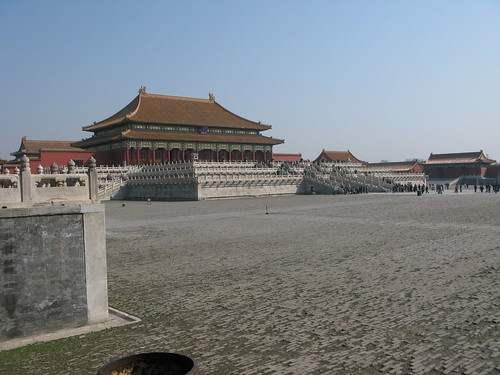
Friday, February 26, 2010
HPM Newsletter 73
Articles and notices for future issues are greatly appreciated.
